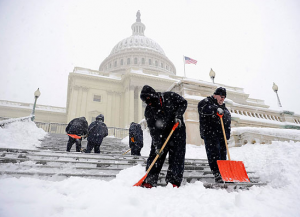
Yesterday, most of the mid-Atlantic was battered by a blizzard that paralyzed much of the nation's capital. Leave it to the pundits and skeptic talking heads to jump on this opportunity to claim that recent heavy snowstorms and cold weather are proof that global warming isn't real.
And while this makes for a nifty headline, dig a little deeper and you'll find the truth.
I'm not a scientist, so I turn to the experts for the facts, not the rhetoric, and meteorologists and climate scientists will tell you there is a significant difference between weather and climate. Weather is our day to day experience while climate is more static describing a region's typical weather conditions as established over periods of time. Climate allows us to know that we can expect Paris to have warm summers and cold winters and that Los Angeles won't see snow next Christmas.
When we talk about climate change, we are not talking about a year with a harsher than usual winter, but a pattern of changes that occur over decades as has been happening over the past decade.
So despite what has been an unusually harsh winter, according to NASA, 2009 was tied for the second warmest year in the modern record, and in the Southern Hemisphere, 2009 was the warmest since records began in 1880. And despite variability from year to year, when averaged over five or ten years, the data shows that global warming is continuing unabated.
With this warmer planet also comes something most of the general public would not expect: more precipitation which means more rain and snow.
A report by the U.S. Global Change Research Program (USGCRP), found overall increases in global precipitation averages with substantial changes in the amount, intensity, frequency, and type of precipitation as a result of global warming.
Marked increases in precipitation have been observed in eastern North America, southern South America, and northern Europe, while certain regions, including the Southwestern United States and the Mediterranean, are expected to become drier. The report adds, “[t]he widespread trend toward more heavy downpours is expected to continue, with precipitation becoming less frequent but more intense.”
These changes are in step with the news of the day: “Heavy snow pummels the East Coast,” “at least 43 people dead in Mexico as a result of the intense rains and flooding affecting large portions of the country since the middle of last week.” According to the USGCRP, these changes are associated with the fact that warmer air holds more water vapor evaporating from the world’s oceans and land surface; an increase observed from satellites, and due primarily to human influences.
So while visibility in Washington, DC was less than a block, we must make sure that our world view goes well beyond this winter’s storms to the heart of the matter: climate change is a reality and it is happening now. We can take steps today to cut global warming pollution by controlling greenhouse gases and investing in a clean energy economy, putting US workers back to work and on a path to energy independence or we can bury our heads in the snow and wait for the next storm to hit.
This post originally appeared on NRDC's Switchboard.
Adrianna Quintero serves as Senior Attorney and Director of La Onda Verde de NRDC in San Francisco. NRDC is a non-profit organization dedicated to protecting the environment, people and animals. NRDC was founded in 1970 and is comprised of more than 300 lawyers, scientists and policy experts, with more than one million members and e-activists.

